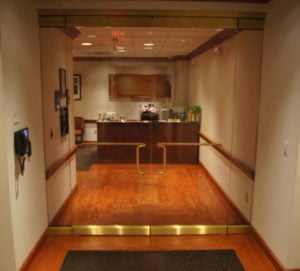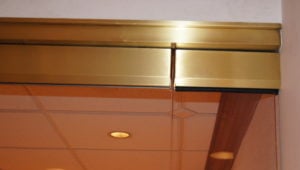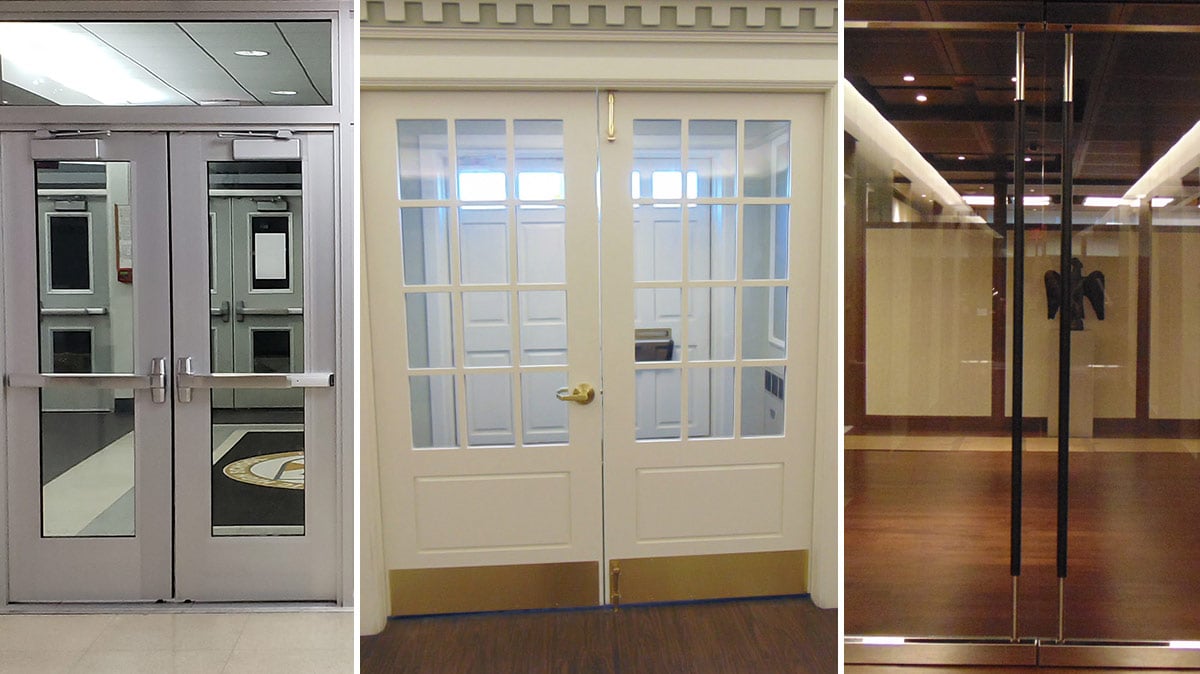Total Security Solutions CEO Jim Richards has often noted that “custom security doors are a lot more common than you think. That’s even more so the case with ballistic security doors. When you’re talking about a business or organization that’s serious about security, odds are good that they’re going to want that door and surrounding walls ballistically reinforced.”
One may ask if bullet-resistant security doors are so common, why haven’t I noticed them? That’s because, in most cases, the best front doors for security are custom made, and built to blend into the existing decor while keeping everyone safe and secure.
In-house Security Door Fabrication
A security system is only as good as its doors. A fortress with an unlocked gate is no fortress. A bullet-resistant window in a plain old wooden door isn’t keeping anyone protected. If a door sticks and annoys occupants, they are likely to prop it open—and an open door has never stopped a single bullet.
Every experienced builder knows that prefabricated doors are never a perfect fit. Under normal circumstances, this is no big deal. A little shimming, perhaps some paint sticks or a scrap of cardboard, some artful spackling and you’re good to go.
But you don’t want to improvise like this in a security situation. And frequently, with security doors, you simply can’t. Ballistic security doors are made of harder, denser building materials. Manufacturers cut and fabricate these materials on specialized machines, like waterjet cutters and CNC routers. As a result, security doors aren’t just more expensive than other doors. They also tend to be at least twice as heavy. That means extra blocking in doorways, heartier continuous hinges, and no way to shave, shimmy, or otherwise persuade a door that almost fits to actually do so.

TSS Standard Security Doors
That is why good physical security companies don’t use prefabricated doors. Ideally, they fabricate all their own doors entirely in-house. By custom building their own doors, they can be sure that any hardware the end-user wants is perfectly fitted, and the door is properly prepped for easier installation and seamless integration with any access control system.
Total Security Solutions (TSS) currently offers seven “standard” bullet-resistant security door styles:
- Ballistic Aluminum Storefront Doors with narrow or wide stile rails and full-vision ballistic windows
- Classic Bullet-Resistant All-Steel Doors with or without ballistic windows
- Ballistic Wood Doors with internal bulletproof door panels and optional ballistic window
- Cost-conscious Bullet-Resistant Acrylic Doors with narrow aluminum frames and acrylic-based ballistic windows
- Single or double divided Lite Wood Doors, with internal bulletproof door panels and the full range of ballistic window materials and security levels
- “Frameless” All-Glass Ballistic Doors available as single or double doors with a “floating” no-stile design
- All-in-One Bullet-Resistant Transactional Doors in wood or steel with internal bulletproof door panels and integrated transaction window
Custom Bulletproof Doors
TSS CEO Jim Richards notes that, although TSS offers “standard doors,” they aren’t a cookie-cutter commodity item. “We don’t crank doors out by the hundreds and stack them up in a warehouse.”
TSS fabricates each door for its specific location. They can make any number of tweaks and adjustments during that process, ensuring that door perfectly meshes with your specific application.
“This is one of our major strengths. The first is that we have deep knowledge of both our specific niche and of building and construction in general. We can bring those pieces together to design solutions that are easy to integrate with your project and really end up working and looking good. Our other strength is that we have actual manufacturing capabilities, so we can design right out to the edge of what’s possible to fabricate.”
Although the bulk of TSS’s customers want their custom security doors in just a few sizes and configurations, each door is still handmade by a skilled tradesperson. Customization is baked into the process. And that customization goes well beyond choosing the paint color or wood veneer finish.
Total Security Solutions can readily customize any of the standard doors: any size, any hardware, any sort of window (even operable transaction windows), peepholes, view scopes, overhead transoms, properly prepped to accommodate your access control system, and so on. Heavy-duty continuous hinges, pneumatic door closers, high-security locksets, and anti-jimmy plates are standard.
Bullet-Resistant Security Doors
Any true bullet-resistant material carries a “UL rating.” This means they’ve been lab-tested to confirm they will stop at least some specific number of bullets of some specific size. For example, a Level 2 bullet-resistant security door will stop at least three shots from a .357 Magnum, while a Level 3 door will stop at least three shots from a larger .44 Magnum (as well as shots from all small pistols, like .357 Magnums, .38 Special, 9mm, .32, .22, and so on).
In practice, many bullet-resistant components will outperform their rating. For example, TSS’s Level 3 doors are tested to confirm they will stop three .44 Magnum bullets. Nonetheless, in the video below you’ll see a TSS Level 3 steel door stop more than 100 rounds from every sort of firearm, including high-powered assault weapons and tactical rifles. Even after all that abuse—and despite only being rated for a single cluster from a pistol—not a single shot even so much as dimples the secure side of the door.
Every TSS door style is available in a Level 3 version. Most styles are available up to Level 5 (able to stop rounds from assault rifles like the AK0-47). TSS’s classic wood and steel doors are available in security levels up to Level 8. That’s the highest level of bullet resistance in conventional commercial barriers, able to stop multiple bursts from every type of gun and rifle.
Download our guide: 5 Things to Consider When Purchasing a Ballistic Door
Access Control
The access control system is the cornerstone of building security. A modern access control system integrates a variety of independent building systems and functions. And that all comes together at each security door.
In a building-wide access control system, each individual user can have customized access to different spaces. Access might need to be granted on a temporary or conditional basis (e.g., only on weekdays, only between 8 am and 5 pm, etc.). A system can have 100,000 users or just 10. It can be accessed via keypad, card, RFID tag, or
“These are really incredibly flexible systems,” Jim Richards notes. “But without seamless collaboration among vendors, it just will never work right. Before an architect or organization starts talking to any vendors, what’s most important is that the provider of your custom security doors and barrier system takes a detailed look at your daily operations. How will most end users work with the doors and barrier every single day? The entire system needs to be designed around that.”
TSS has a great deal of experience designing and fabricating custom security doors around the demands of an access control system. That has included integrating power supplies, electric strikes, electrified hinges, key cards, and video monitoring in each door frame. This allows the security integrator to quickly tie all the elements of the system together, making an overnight or weekend installation possible (even with a multi-part security system).
“What separates TSS is that we’re eager to work with other security vendors as equals. Other companies in our industry really shy away from that. They don’t understand access control, so they don’t want to deal with it. We’re not scared of these types of challenges.”
TSS “Stealth” Custom Security Doors
Some facilities need more than just a custom finish or a few tweaks to a standard design. They want new security doors that seamlessly match the existing aesthetic such that a visitor returning after the installation will have no idea that the doors have been replaced with high-security doors.
According to Jim Richards, “Corporate headquarters, religious institutions, government offices: these users, they’re usually making an investment not just in security, but in making sure to blend these new secure elements into the existing decor. Because we have so many decades of experience doing custom work, we can make that happen.”

As an example, he shares the above custom security doors. “This is the kind of custom work we can do on a one-off. At the time, no one in our industry had ever done doors like these. Those door lites aren’t individual panes. Each door has a single piece of monolithic acrylic, visually divided by false muntins that we built from scratch, precisely blended to the surface of the door.”
The doors themselves are backed with bullet-resistant fiberglass and integrated into the building-wide access control system. They are indistinguishable from any other door in the building.
Another good example is this all-glass door Total Security Solutions created for a corporate headquarters in Connecticut. The client needed a set of durable bullet-resistant doors that matched the existing doors as closely as possible so that the renovation would not draw any attention.

Total Security Solutions designed, engineered, and fabricated these doors from extremely durable Level 2 glass-clad polycarbonate. They sourced all the hardware themselves, finding pieces that would blend with the existing decor, but were hearty enough to handle the extra weight of using ballistic glazing in a “floating” frameless door of this type.

custom all-glass door hardware detail
Safety Concerns About Emergency Door Barricade Devices
Facility managers and building occupants sometimes seek to affordably convert existing doors into “security doors” with aftermarket modifications. “Door barricade devices” are the most common examples. These are secondary door locks that use a wedge, bracket, or cleat to secure a door to the floor or its frame.
Such solutions can seem extremely attractive—especially when compared to the cost of replacing standard doors with custom security doors.
But experts warn that these solutions rarely comply with building codes, fire codes, or accessibility standards. In fact, these products are so controversial that as of December of 2018 Campus Safety magazine stopped accepting advertising dollars from companies whose school door barricades fall short of safety and accessibility standards.
Jim Richards has decades of experience increasing physical security in public buildings and doing it while working within ADA requirements and fire codes.
“On the surface,” Jim notes, “these emergency door lock devices for schools and other facilities look great. I see people reacting to these things. They see pictures online, watch a YouTube video of a big burly guy totally unable to force that door open. They say ‘These look awesome!’ But are they effective? Do they accomplish that without creating new hazards? As someone who’s been doing this his entire career, I have some concerns.”
Security Doors Vs. the ‘Mantrap’
Businesses are increasingly drawn to the fully automated “mantrap” as the “perfect bulletproof security solution.” These are forced entry-rated bulletproof doors that automatically lock out the ill-intentioned, but let staff and legitimate customers pass through unhindered.
The idea is to end up with something like an airlock: a visitor enters through exterior doors, passing into a secured vestibule with locked bulletproof doors at the other end. The mantrap then scans the visitor for weapons. If he or she comes up clean, the system unlatches the interior bulletproof doors automatically. Those who fail the scan cannot pass into the facility—or are even trapped by automatically-locking exterior doors.
While the concept of the mantrap is ideal, many problems arise in implementation. They only come in one or two pre-fabricated configurations. If an existing building needs to add a mantrap, the installers are almost certainly going to have to move walls and enlarge entryways. In many older buildings, it is extremely hard to accommodate the new hardware while staying within building/fire codes, handicap-accessibility guidelines, and so forth. Subsequently, these very expensive systems bring with them a cluster of added costs. If a building has multiple entrances, each either needs its own mantrap or must be sealed off.
Once installed, automated mantraps need frequent servicing:
They rely on the complex integration of software and hardware systems. That includes metal detectors, microcomputers, and relays controlling the bulletproof doors. Even with regular calibration, a metal detector doesn’t know the difference between a gun, a knife, a tape measure, and a laptop or smartphone. As a result, mantraps have an annoyingly high “false-positive” rate. (For example, see this “False Positive” anecdote.)
Custom Security Door Installation Support
While TSS offers full end-to-end security door installation, many clients prefer to use their local or staff contractors. In these cases, TSS usually ships custom security doors that are ready to hang and primed, but unfinished, so that on-site contractors can paint or stain them to match the decor of the installation. Properly finished wood-veneer ballistic doors look terrific, offering full-fortress security without compromising a professional atmosphere. Unfortunately, it’s all too common to see a $5000 ballistic door with a finish that’s not even worth ten bucks. TSS is happy to support local contractors at every stage of a bulletproof barrier installation job. That includes the final finishing details.
Steel-clad and all acrylic bullet-resistant doors are significantly less tricky to properly finish. TSS ships steel bulletproof doors primed and ready to paint on-site—making it easy for contractors to be able to finish in short order. Nonetheless, Jim still advises facility managers to take care in selecting the paint color and finish for their steel doors. For example, high-gloss finishes can quickly show every scuff and ding under fluorescent lighting.
In terms of ease-of-installation and long-term durability, it’s hard to beat an all-acrylic bulletproof door. Because TSS fully fabricates, and flame polishes the acrylic at the factory and the door ships with all hardware installed. That means virtually no on-site finishing to worry about. From there, it’s just a matter of proper cleaning and maintenance to maintain beautiful doors for the long haul.


